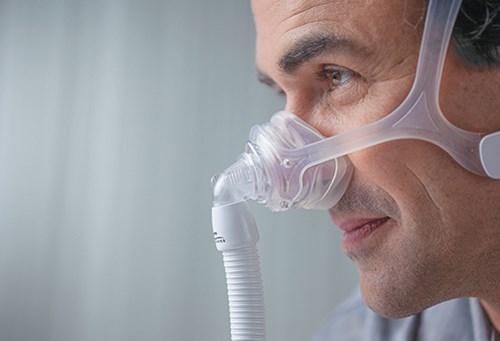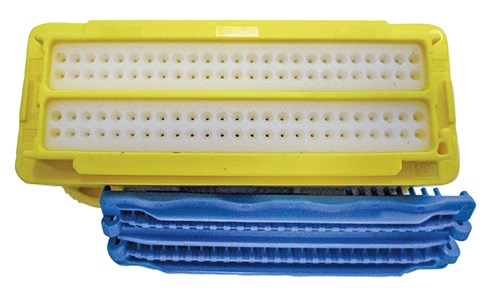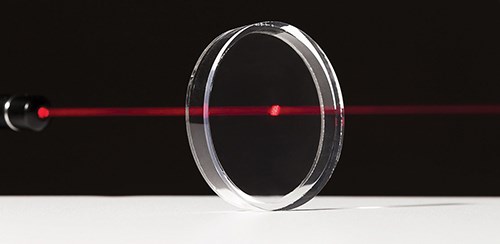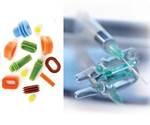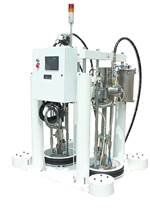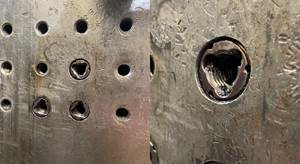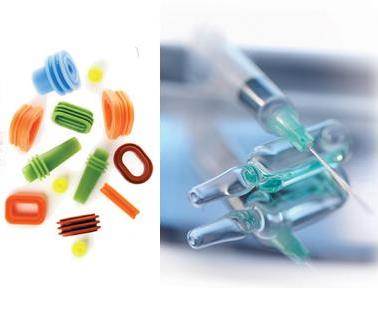Clearly a Contender
LSR Vies for New Applications in Automotive, Lighting, Healthcare, and More.
The use of injection moldable liquid silicone rubber (LSR) has been on an upsurge over the last few years, with emerging applications in automotive, lighting, healthcare, infant products, electronics, and industrial markets. Global annual growth estimates are now in the double-digits (15-18%).
“LSR is becoming more popular and its growth is due to the productivity that is achievable, as well as the good infrastructure of experienced processors and machine suppliers,” says Hans Winkelbach, sr. director of marketing and technology at Momentive Performance Materials, Strongsville, Ohio.
LSR is touted for its excellent property profile: It is chemically inert, has good chemical and UV resistance, remains flexible and elastic below -70 F and retains its properties at up to 450 F. It offers elongation of 100-900%, is fatigue and compression-set resistant, and provides superior electrical insulating characteristics. LSRs are bacteria-resistant, lubricious, sterilizable, biocompatible, and both short- and long-term implantable in medical applications.
LSR’s key advantage over high-consistency silicone rubber is in molding cycle times: as little as 30 sec vs. 3-5 min for HCR. And due to its extremely low viscosity, LSR can be used for complex molded parts with finer detail and tighter tolerances than are often possible with other materials. When molded onto thermoplastic substrates, the resulting multi-material performance options are numerous.
Florian Degenhart, communications spokesman for Wacker Chemie (U.S. office in Adrian, Mich.;) noted that his company launched a campaign at last month’s Fakuma 2014 show in Germany to address increasingly demanding applications and product requirements of various LSR markets. “Most of our standard LSR grades already have a Shore hardness spec of ± 3. Our new Sigma 1 and 2 grades show Shore hardness tolerances of ± 1 and 2, respectively. This is especially important for some applications such as vibration-damping components or pressure-sensitive valve systems.”
Among the emerging LSRs are fluorosilicones for enhanced chemical resistance, self-lubricating silicones that assist in assembly and application usage, self-adhesive materials for multi-material overmolding applications, and optical-grade silicones that offer high-temperature resistance along with optical clarity—suiting them to the booming field of LED and other lighting applications.
LSR STARS IN HEALTHCARE
LSR is gaining recognition in medical devices such as seals, plungers, and gaskets. Growing demand for home healthcare and disposable devices has opened new opportunities from catheters and self-diagnostic units, to needle-free valves and sleep-apnea masks.
Dow Corning, Midland, Mich. has developed what it calls a new industry benchmark for LSR in the medical arena. Bill Inman, applications engineer, says the new QP1-200 series utilizes a unique chemistry that limits the amount of “structure build-up” during injection. “There is a lot of hydrogen bonding taking place during processing, which increases the LSR’s viscosity, making it harder to process,” Inman explains.
These new grades, to be introduced to North America in February, come in Shore A 30 to 70, and are said to retain their initial low viscosity during processing. Fabricators can expect a lot more processing flexibility, with lower injection pressures and times, according to Inman.
The primary target for the new series is short-term implantables and non-implantables such as catheters, access valves, diaphragms, and O-rings for infusion pumps. As the devices become ever smaller, these low viscosity LSRs will be good candidates for micromolding. They also have good potential for use in infant care. In addition, Dow Corning has conducted trials in sheeting applications, as these LSRs offer a new way to process wound- and scar-care products at a lower cost. The new LSRs can be dispensed onto a sheetstock backing of PUR, for example, in place of PUR or silicone gel, and then cured in an oven to create a thin silicone-rubber membrane.
The company also has developed selective-adhesion LSRs that bond better to thermoplastics in overmolding, without a primer. To be launched commercially later next year, these LSRs will be targeted to applications such as full-face and nose sleep-apnea masks which can be two-shot molded with a stiff PC backing and the soft, biocompatible LSR for the face contact material.
In January of this year, Shin-Etsu Silicones America, Akron, Ohio, opened its new LIMS (Liquid Injection Molding System) Technical Center. At the opening ceremony, Eric Bishop, North America marketing manager, hinted at some of the new LSRs to come, and highlighted the company’s Select-Hesive LIM KE2090 Series, which complies with USP Class VI and ISO 10993 standards for healthcare applications and is designed for primerless adhesion to a wide variety of thermoplastics. These LSRs, with Shore A hardnesses as low as 10, had already been shown to adhere to PC, PBT, modified PPO, PEEK, polysulfone, and polyphenylsulfone.
Shin-Etsu has two new self-bonding LSRs. One is extremely soft KE2090-5 (05 Shore A), suitable for facial contact applications such as apnea masks, which have already been brought to market by one customer. The other is developmental grade X-43-4172, designed to bond to a wider range of substrates. Says Bishop, “In addition to bonding to PC, PBT and PPO, we can now bond to Ultem PEI, amorphous nylon 12, and nylons 6 and 66. The advantage of being able to overmold with these higher-temperature materials is that you can reduce cycle time.” Potential applications range from healthcare to automotive connectors and household items. For example, this LSR overmolded onto nylon 12 offers a BPA-free alternative to PC for healthcare masks and baby-bottle nipples.
Bluestar Silicones North America, East Brunswick, N.J., has added new low-durometer (Shore A 01, 05, 10, and 25) LSRs under its Bluesil and Silbione lines, which boast uniquely high tear and elongation properties among low-durometer LSRs for healthcare and general-purpose applications. Karen O’Keefe, elastomers business director, says product designers can now go lower in hardness without sacrificing performance for applications like face masks, cushioning mats, prosthetic liners, infant products, and balloon-type applications.
Meanwhile, a new low-volatility LSR line is available from Shin-Etsu and aimed at bottle nipples and other infant feeding products. KEG-2003H, with a 30-70 Shore A range, does not require post-cure in order to meet the most stringent low-VOC regulation, the European EN14350. These grades also have potential in medical devices such as valves, seals, and diaphragms.
Development of lower-temperature-curing LSRs for overmolding on lower-melting thermoplastics (250-275 F) could open up new medical uses. This is another focus at Dow Corning, which aims to launch the first of these in 2016. The minimum cure temperature for current LSRs is 250-300 F, but Inman says DC is aiming for LSRs with cure temperatures of 200 F. Applications could include cardiac pacemakers, where LSR could replace a PUR casing over the battery pack and lower-melting thermoplastics could replace components of more costly engineering resins.
A recent novel development from Momentive is UV-curable LSR. This enables processors to inject into a room-temperature mold that has a transparent “window” through which UV light is shined onto the LSR. Winkelbach says this makes it far easier to overmold low-melting thermoplastics like PP or to use LSR for encapsulating sensitive electronics. Healthcare uses could include lighting strips and catheter valves.
Long-term implantable silicones, which can remain in the body for at least 30 days, are another growth area. Two of the key players in this segment now are Applied Silicone Corp., Santa Barbara, Calif. and NuSil, Carpinteria, Calif. Applied Silicone, for example, has made investments in added space and equipment to increase its LSR production by 50%.
Applied Silicone is now a global supplier of long-term implantable LSRs, gels, and adhesives that meet requirements of ISO 10993-1. According to Norman Riley, technical marketing director, it offers LSR systems in a broad durometer range, including grades with 1:1 mix ratio for automated high-volume processing and others with a 10:1 ratio for limited production runs or customized long-term implantable devices.
Bluestar also plans to enter this market segment. O’Keefe says the company will soon launch “next-generation” LSRs for long-term implants in hardnesses of Shore A 01 through 70. When commercialized, the Silbione Biomedical line will reportedly offer outstanding physical properties and ease of processing.
AUTOMOTIVE, LIGHTING, ELECTRONICS
Lots of activity is also taking place in automotive, lighting, and electronics. Craig Gross, sr. application engineer at Dow Corning, points to two recently commercialized 100%-fluorinated LSRs that combine the chemical resistance of high-consistency fluorosilicone rubber with the ease and efficiency of LSR processing. Silastic FL-60-9201 and FL-70-9202 (Shore A 60 and 70, respectively) offer fabricators with conventional LSR molding equipment an option for applications that require a broad resistance to fuels, oils, and solvents, so automotive application is a primary target.
They boast a significantly lower volume swell of 25-35% in contact with such fluids, vs. 120-130% for typical LSRs, and they process at lower temperatures. Applications being pursued include umbrella valves, duckbill valves, diaphragms, and O-rings. “We are excited about a new membrane application for which we were recently qualified, given the material’s quick, lower-temperature cure and the potential for plastic overmolding,” says Gross. These LSRs can be cured at 250-280 F, allowing for overmolding on thermoplastics such as nylon 66 and PBT.
Two recently introduced LSRs from Wacker make LSR a good contender for injection molded gaskets in automotive cooling systems. Parts made with Elastosil LR 3022 Shore A 60 LSR reportedly retain low-compression set under long-term load in direct contact with coolant fluids. Standard LSRs are not suitable as sealants in the hot areas of engine cooling circuits as they quickly lose elasticity and rebound resistance, but this LSR has been shown to retain its rebound resistance “permanently,” which ensures leak tightness in the seal groove.
Similar advantages are claimed for new 63 Shore A Elastosil RT 728. However, this LSR is also room-temperature curable by open dispensing straight onto the part to be sealed. Gaskets made with it exhibit no more than 30% compression set after 1000 hr in coolant at 221 F (105 C). Even after 1000 hr at 257 F (125 C), permanent deformation is less than 65%. Automotive suppliers like Germany’s Mahle are using it to make radiator parts.
Another recent Dow Corning development is the Silastic RBL-920X series, which expands on the improved-rheology, lubricated grades of the Silastic Z RBL-9200 line. Available from 20 to 50 Shore A with various levels of internal lubricant, they boast excellent compression-set values of <25% after 22 hr at 347 F/175 C. Their higher flow results in better process control, a wider processing window, and ability to fill thin walls. Targets include weatherpack seals, mat seals for electrical connectors, and perimeter seals.
At Fakuma 2014, Momentive introduced Silopren LSR 3376/50, the first of its new low-volatility, self-lubricating LSR family that can meet new stringent safety specifications for automotive electrical systems. The material can address the critical need of manufacturers for connector seals that have very low levels of volatiles and do not require post-curing to achieve this.
A new application for another of Momentive’s new materials, Silopren 3696-25, is mat seals of automotive sensor connectors that need environmental protection. This material boasts an excellent compression set along with low (25 A) hardness, as well as an external lubricant that migrates to the surface.
Shin-Etsu’s Bishop sees the company’s developmental X-43-4172 as suited to overmolding high-temperature plastics such as PEI for automotive matte seals and perimeter seals, as well as high-end spatulas. He also sees new low-volatility KEG-2003H as a candidate for electronic sealings where volatiles must not impact electronics.
In the lighting market, LSR offers high productivity, low reject rates, and excellent weatherability. Lighting is one market focus for Momentive, whose new Silopren LSR7000 is aimed at high-powered LEDs that can reach temperatures up to 302 F (150 C). Says Winkelbach, “LSRs like this one have excellent heat, UV, and moisture resistance and will not discolor, outperforming competitive materials—PC and acrylic. We are enabling LED lighting that wasn’t possible before with a long-term life for applications such as street lights and automotive.” Winkelbach hinted that an undisclosed 2015 car model will feature this LSR in a headlamp that houses a high-temperature “active-matrix” LED for which this LSR is well suited.
Three new LSRs for optically clear products were also launched by Shin Etsu in Shore A 70 and 80 with transparency of 95% and a refractive index greater than 1.41. Target uses include LED lighting components from streetlights to automotive and safety lighting.
Wacker launched high-transparency Lumisil LR 7600 last year for lenses in adaptive front-lighting systems for cars. Most premium and mid-range car models feature adaptive lighting, and the auto industry aims to equip compact and small cars with such systems at affordable cost. Wacker says its “crystal clear” LSR enables cost-efficient large-scale production of optical elements and offers new possibilities for the passenger compartment to be virtually stage-lit with indirect light from LED.
New from Momentive is Silopren Matrix fiber-reinforced LSR—the fiber can be nylon or PET—which combines the flexibility of a silicone elastomer with the high strength of polymeric fibers for applications that require increased stiffness and are comfortable against the skin, such as wristbands for wearable electronic devices. It boasts excellent UV resistance, is easily colored, and can lower costs by eliminating the need for an additional fabric layer.
Momentive also just unveiled antistatic heat-cured Silplus 30 AS, which eliminates static without the use of carbon black fillers, enabling fabricators to create products in a variety of colors, as well as translucent products such as keyboard covers, elastomeric keypads and buttons, and soft-touch features on electronic devices.
Bluestar has what it calls a “game-changing” LSR technology to be unveiled in early 2015. The patented LSR Select allows molders to adjust the LSR cure rate on the machine before and during the production process, resulting in 20-50% cycle-time improvements.
Related Content
Carbon Fiber Reinforced Nylon 12 for Injection Molding
CRP Technology’s new composite is 100% recycled from Windform XT 2.0 IMG industrial 3D printing material.
Read MoreInjection Molded Enclosures Plug into Potential Electric Vehicle Battery Applications
In partnership with material suppliers, Engel is proving out injection molded thermoplastic-based concepts for electric vehicle battery housings, utilizing production tools and dedicated machines at its large press factory in St. Valentin, Austria.
Read MoreIndustrial Resin Recycling Diversifies by Looking Beyond Automotive
Recycler equips for new business in medical, housewares and carpeting.
Read MoreMolder Repairs Platen Holes with Threaded Inserts
Automotive molder ITW Deltar Fasteners found new life for the battered bolt holes on its machine platens with a solution that’s designed to last.
Read MoreRead Next
Getting Into LSR: Part II--Chosing an Injection Machine
The criteria for selecting a liquid silicone rubber injection molding machine are very similar to selecting a machine for standard thermoplastic injection molding, with several key differences.
Read MoreGetting Started in LSR: Understanding the Materials, Part I
Liquid silicone rubber (LSR) injection molding is a long established process but it is enjoying an upsurge in interest for medical, automotive, infant care, and general industrial applications.
Read MoreLSR Part III-- Choosing a Mixing/Metering System
Liquid silicone rubber (LSR ) is a two component reactive chemical with a viscous, paste-like consistency.
Read More


